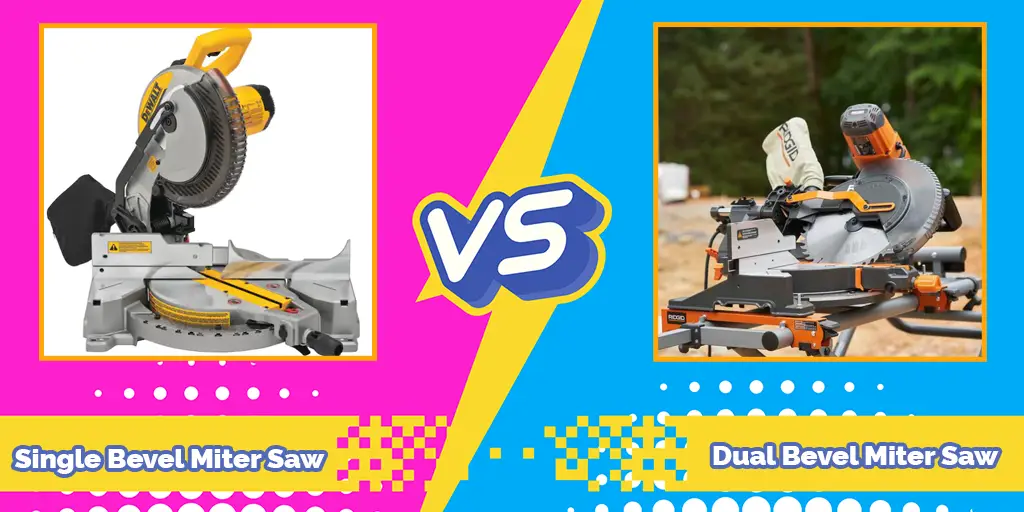When embarking on a woodworking or DIY project, the choice of tools can significantly impact both the process and the outcome.
Among these tools, miter saws stand out for their precision and versatility in making angled cuts. However, a common dilemma faces many: Should one opt for a single or a dual bevel miter saw?

This comprehensive guide delves into the world of miter saws, unraveling the intricacies of single and dual bevel models. It’s designed for everyone from the weekend DIY enthusiast to the seasoned professional.
By the end of this article, you’ll have a thorough understanding of the capabilities, advantages, and limitations of each type of saw, empowering you to make an informed decision for your specific needs.
We will explore the basic concepts, delve into the specifics of bevel cuts, compare the single and dual bevel miter saws in depth, and provide practical tips to guide your purchase.
Whether you’re crafting intricate crown molding or framing a new addition to your home, the right miter saw can make all the difference.
Let’s embark on this journey to discover which miter saw – single or dual bevel – is the ideal choice for your woodworking adventures.
Knowing Miter Saws
Miter saws, a staple in woodworking shops and construction sites, are specialized tools designed for making precise angled cuts.
These powerful machines are pivotal for projects requiring accuracy, such as framing, crown molding, and decorative trim work.
Understanding the fundamental aspects of miter saws is essential for any craftsperson looking to utilize these tools effectively.
The Essence of a Miter Saw
A miter saw comprises a blade mounted on a swing arm that pivots left or right to produce angled cuts. This simple yet ingenious design allows for swift and accurate crosscuts in wood. Here are the key components:
- Blade: Available in various sizes, typically ranging from 8 to 12 inches in diameter.
- Motor: Powers the blade, with varying power outputs to suit different cutting needs.
- Miter Index: Allows users to change the angle of the blade with precision.
- Fence: Provides stability and support to the workpiece during the cutting process.
The Evolution in Woodworking
Miter saws have evolved from basic manual models to sophisticated power tools. This evolution reflects the growing demands for precision and efficiency in woodworking and construction.
The modern miter saw not only provides precise angle cuts but also offers features like laser guides and dust collection systems, enhancing the user experience.
Components and Their Functions
Each component of a miter saw plays a critical role:
- Blade: Determines the type and quality of the cut. Larger blades can make longer cuts.
- Motor: The power source that drives the blade. Higher amperage motors deliver more cutting power.
- Miter Index: Allows for accurate angle adjustments, crucial for fitting pieces together seamlessly.
- Fence: Ensures accuracy and safety, acting as a guide for the workpiece.
Understanding these components and their functions is the first step in choosing the right miter saw for your project.
Whether you opt for a single or dual bevel miter saw, knowing the basics of these tools will enhance your ability to make informed decisions and execute your projects with precision.
What is a Bevel Cut?

Understanding what a bevel cut is, is crucial in grasping the fundamental difference between single and dual bevel miter saws.
Bevel cuts are not just simple angled cuts; they are more complex and versatile, adding a new dimension to woodworking projects.
The Definition and Significance of Bevel Cuts
A bevel cut is an angled cut made along the edge or end of a material, typically wood. Unlike a standard miter cut, which is made across the width of the material, a bevel cut angles the material’s surface.
This type of cut is essential for creating joints in trim work, framing, and cabinetry, allowing pieces to fit together seamlessly at various angles.
Applications in Woodworking Projects
Bevel cuts are widely used in several applications:
- Crown Molding and Trim Work: For seamless corner joints.
- Picture Frames: To create angled edges that fit together precisely.
- Furniture Making: For aesthetic and functional joinery.
- Custom Woodworking Projects: Where creative and complex angles are required.
Visual Examples and Illustrations
To fully appreciate the utility of bevel cuts, visual examples can be immensely helpful. Imagine a picture frame; the corners are not merely cut at 45-degree angles but are also beveled to give a sloping edge.
This technique adds depth and character to the frame, exemplifying the bevel cut’s importance in woodworking.
Understanding bevel cuts lays the foundation for comprehending the advantages and limitations of single and dual bevel miter saws.
With this knowledge, woodworkers and DIY enthusiasts can better decide which type of saw will best suit their project needs.
Single Bevel Miter Saws
Single bevel miter saws are a popular choice among woodworkers and DIY enthusiasts for their versatility and ease of use.
Understanding their design, use cases, and user experience is key to assessing whether this type of saw is the right fit for your projects.
Design and Mechanism
A single bevel miter saw can pivot its blade and head in one direction, typically to the left. This design allows the user to make bevel cuts in one direction without needing to flip the workpiece. Key features include:
- Single-direction Pivot: Simplifies operations and reduces setup time.
- Adjustable Bevel and Miter Settings: Offers versatility for various cut types.
- Compact Size: Generally lighter and more portable than dual bevel models.
Ideal Use Cases and Limitations
Single bevel miter saws are suitable for a range of projects, but they also have some limitations:
- Ideal for: Basic framing, trim work, and simple cabinetry.
- Limitations: For cuts in the opposite direction, the workpiece must be manually flipped, which can be time-consuming and less precise.
User Experience: Ease of Use and Challenges
Users of single bevel miter saws often report:
- Ease of Use: Straightforward operation, making it suitable for beginners.
- Challenges: Flipping the workpiece for opposite bevel cuts can lead to alignment issues and inconsistency, particularly for less experienced users.
In conclusion, single bevel miter saws are an excellent choice for those starting in woodworking or for projects that don’t require frequent opposite bevel cuts.
Their simplicity and lower cost make them a viable option for many, though they may not be the best choice for more complex projects requiring a variety of bevel cuts.
Dual Bevel Miter Saws
Dual bevel miter saws elevate the capabilities of their single bevel counterparts, offering greater flexibility and efficiency for intricate woodworking projects.
Understanding their advanced design features, benefits over single bevel saws, and ideal usage scenarios can help you determine if a dual bevel miter saw is the right choice for your needs.
Advanced Design Features
Dual bevel miter saws are engineered to pivot their blade and head in both directions, eliminating the need to flip the workpiece for opposite bevel cuts. Key features include:
- Bi-Directional Pivoting: Allows cuts in both directions without repositioning the workpiece.
- Precision and Consistency: Enhanced accuracy for complex projects.
- Advanced Safety and Convenience Features: Often equipped with better safety mechanisms and user-friendly adjustments.
Comparing with Single Bevel: Pros and Cons
While dual bevel saws offer clear advantages in certain scenarios, they also come with some considerations:
Advantages:
- Time-saving and efficient for projects requiring multiple bevel cuts.
- Greater consistency and accuracy in complex cuts.
Cons:
- Typically more expensive than single bevel saws.
- Heavier and less portable, which might be a factor in some workspaces.
Situations Where Dual Bevel Excels
Dual bevel miter saws are particularly beneficial in:
- Advanced Trim Work and Cabinetry: Where precision and symmetry are crucial.
- Complex Framing Tasks: Efficient in handling multiple angles.
- Professional Woodworking Projects: Where time efficiency and accuracy are paramount.
Dual bevel miter saws are a powerful asset for advanced woodworking projects that require precision and efficiency.
While they come at a higher cost and might be more complex to handle, their ability to make quick, accurate, and diverse cuts makes them a preferred choice for professionals and serious hobbyists.
In-Depth Comparison

When choosing between a single and dual bevel miter saw, understanding the nuances of each is crucial.
This in-depth comparison focuses on efficiency, accuracy, and the cost-benefit aspects to help you make an informed decision.
Efficiency and Time Management
Single Bevel Miter Saws:
- Efficiency: Suitable for simpler projects with fewer bevel cuts. Time-consuming for projects requiring cuts in both directions.
- Time Management: Manual flipping of the workpiece for opposite cuts can extend project duration.
Dual Bevel Miter Saws:
- Efficiency: Highly efficient for projects with multiple and varied bevel cuts. Saves time by eliminating the need to flip the workpiece.
- Time Management: Ideal for professionals and complex projects where time is a crucial factor.
Accuracy and Precision in Cuts
Single Bevel Miter Saws:
- Accuracy: Sufficient for basic tasks, but flipping the workpiece can introduce errors.
- Precision: Good for straightforward projects but may lack consistency for complex angles.
Dual Bevel Miter Saws:
- Accuracy: Superior, especially for intricate and repetitive cuts.
- Precision: Maintains consistent angles and joints, crucial for high-quality finishes.
Cost-Benefit Analysis
Single Bevel Miter Saws:
- Cost: Generally more affordable, offering good value for basic needs.
- Benefit: Ideal for beginners or those with occasional miter cutting needs.
Dual Bevel Miter Saws:
- Cost: Higher initial investment.
- Benefit: Long-term efficiency and precision make it a worthwhile investment for serious woodworkers and professionals.
The choice between single and dual bevel miter saws depends on your specific needs. If your projects are straightforward or you’re just starting, a single bevel might suffice.
However, for more complex, detailed work or in a professional setting, the time-saving and accuracy benefits of a dual bevel saw are invaluable.
Practical Considerations
When selecting between single and dual bevel miter saws, practical considerations such as workspace requirements, safety measures, and maintenance are essential factors to weigh.
This section provides insights into these aspects, guiding you towards a choice that fits your working environment and habits.
Workspace Requirements
Single Bevel Miter Saws:
- Space Utilization: Generally more compact, making them suitable for smaller workspaces or mobile workshops.
- Setup: Easier to set up and store due to their smaller size and lighter weight.
Dual Bevel Miter Saws:
- Space Utilization: Require more room due to their larger size and dual bevel functionality.
- Setup: May need a permanent space in larger workshops or studios.
Safety Measures
Both types of saws demand adherence to safety protocols, but there are specific considerations for each:
- Single Bevel Miter Saws: The need to manually flip the workpiece for opposite cuts requires extra caution to maintain stability and avoid accidents.
- Dual Bevel Miter Saws: Often come with advanced safety features, but their complexity demands a thorough understanding of their operation to ensure safe use.
Maintenance and Durability
Regular maintenance is crucial for both types of saws:
- Blade Care: Regular cleaning and sharpening extend the life of the saw and ensure clean cuts.
- Mechanical Parts: Periodic checks and lubrication of moving parts prevent wear and tear.
- Dust Management: Proper dust collection systems not only keep the workspace clean but also protect the saw’s components.
Environmental Considerations
The choice of saw can also be influenced by the work environment:
- Noise Levels: Dual bevel saws might generate more noise, which is a consideration in shared workspaces.
- Dust and Debris: Effective dust management systems are crucial, especially in indoor or limited-ventilation areas.
When choosing a miter saw, consider not only the technical specifications but also how it fits into your workspace, your commitment to safety, and the maintenance it requires.
These practical considerations are as important as the saw’s cutting capabilities in ensuring a successful and enjoyable woodworking experience.
People Who Want to Read This Article:
Buying Guide
Selecting the right miter saw can be a daunting task given the variety of options available.
This buying guide aims to simplify the process, highlighting key features to look for, offering a comparison of top models, and providing insights on budget planning.
Key Features to Look For
When purchasing a miter saw, consider the following features:
- Blade Size: Typically ranges from 8 to 12 inches. Larger blades allow for longer cuts.
- Motor Power: Measured in amperage; higher amperage means more cutting power.
- Positive Stops: Quick settings for common angles.
- Laser Guide: For precise cutting lines.
- Dust Collection System: To maintain a clean workspace.
- Safety Features: Such as electric brakes and blade guards.
Top Models Comparison
Consider these popular models for both single and dual bevel saws:
Single Bevel Miter Saws:
- Model A: Known for its precision and affordability.
- Model B: Offers excellent durability and ease of use.
Dual Bevel Miter Saws:
- Model C: Praised for its advanced features and power.
- Model D: Stands out for its accuracy and professional-grade performance.
Price Range and Budget Planning
- Single Bevel Miter Saws: Generally more budget-friendly, ranging from X to Y dollars.
- Dual Bevel Miter Saws: Higher-end models, priced between Z and W dollars.
When planning your budget, consider not only the initial cost but also long-term aspects like durability, maintenance expenses, and the potential need for accessories.
Final Considerations
Remember, the best miter saw for you depends on your specific needs:
- For Occasional Use: A single bevel saw might be more than sufficient.
- For Professional or Frequent Use: Invest in a dual bevel saw for its efficiency and versatility.
Choosing the right miter saw involves balancing features, price, and your specific woodworking needs. By carefully considering these factors, you can select a tool that will be a valuable asset in your workshop for years to come.
Conclusion
Choosing between a single and dual bevel miter saw is a decision that can significantly impact the quality and efficiency of your woodworking projects.
Throughout this guide, we’ve explored various facets of these tools, from their basic designs to practical considerations and user experiences. Here’s a recap of the key points:
Single Bevel Miter Saws: Ideal for beginners and those working on simpler projects. They offer ease of use, affordability, and are well-suited for basic tasks. However, they may fall short in complex projects requiring frequent and varied bevel cuts.
Dual Bevel Miter Saws: Perfect for professionals and serious woodworkers who demand precision and efficiency. These saws excel in complex projects, saving time and ensuring consistency in cuts. While more expensive and heavier, they are invaluable for intricate work.
Final Recommendations
Assess Your Needs: Consider the type of projects you undertake. For occasional, straightforward tasks, a single bevel saw might suffice. For more complex and frequent projects, a dual bevel saw is a worthwhile investment.
Budget Consideration: Keep in mind the initial cost and long-term value. A more expensive tool could offer greater efficiency and durability, saving money in the long run.
Skill Level: Beginners might find single bevel saws more user-friendly, while professionals will appreciate the capabilities of dual bevel saws.
Encouragement for Creative Woodworking
No matter which saw you choose, remember that the true essence of woodworking lies in the creativity and dedication you bring to your projects.
These tools are just a means to turn your vision into reality. Embrace the journey of learning and creating, and let your woodworking skills flourish.
We hope this guide has provided you with valuable insights to make an informed decision on the best miter saw for your needs. Happy woodworking!



